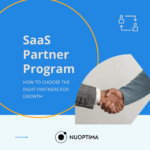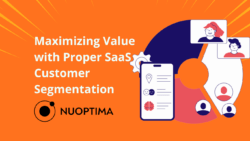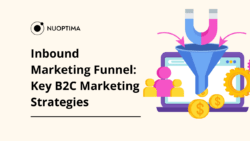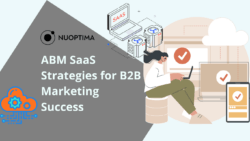Imagine this: You’ve developed a top-tier software solution packed with features that could revolutionize how businesses operate. But here’s the catch – the companies you’re targeting aren’t even aware it exists. A nightmare, right? Well, that’s where the art of B2B SaaS marketing campaigns comes into play.
When we say B2B SaaS startup marketing, we’re delving into the nitty-gritty strategies and tactics that SaaS wizards, like yourself, employ to showcase their software to other businesses. It’s not just about flashing a product; it’s about speaking to the heart of B2B challenges, offering a gleaming solution that feels tailor-made for them.
But how do you craft that perfect message? How do you ensure your SaaS tool isn’t just another needle in the digital haystack? Well, my savvy marketer, that’s why taking a leaf out of successful best SaaS marketing campaigns is nothing short of enlightening. By breaking down the winning formulas, you unearth golden insights, nailing down the aspects that genuinely click with your audience. So, join us on this journey, where we decode the nuances, channels, and tactics that transform an average plan into a B2B SaaS sensation.
1. HubSpot’s Inbound Marketing Campaign
HubSpot’s inbound approach is one of the most well-known and successful B2B SaaS inbound marketing campaigns. One quick Google search on advertising strategies will show a HubSpot article somewhere in the top ten search results. Thus, as you can see, their efforts focused on providing valuable resources to attract and engage potential customers rather than relying on traditional outbound tactics.
Key Elements
Here are the main elements that made HubSpot’s efforts successful:
Thought leadership
HubSpot invested heavily in creating high-quality, educational content that addressed the pain points of its target audience. They distributed this through various channels, including blog posts, ebooks, newsletters, podcasts, social media, webinars, and videos. In fact, since 2018, the demand for online video has nearly doubled [1], a trend that Hubspot has kept ahead of effortlessly.
Additionally, they show their expertise by segmenting their audience by the type of solution they need. For example, they categorize into sales, marketing, and AI, to name a few. Plus, they take this further by placing internal links to relevant articles and videos, leading their audience down to the appropriate inbound marketing funnel. This not only encourages viewers to stay on their website but ensures their content is accessible. Therefore, with its consistent and expansive strategy, HubSpot has secured itself as a category leader in the industry.
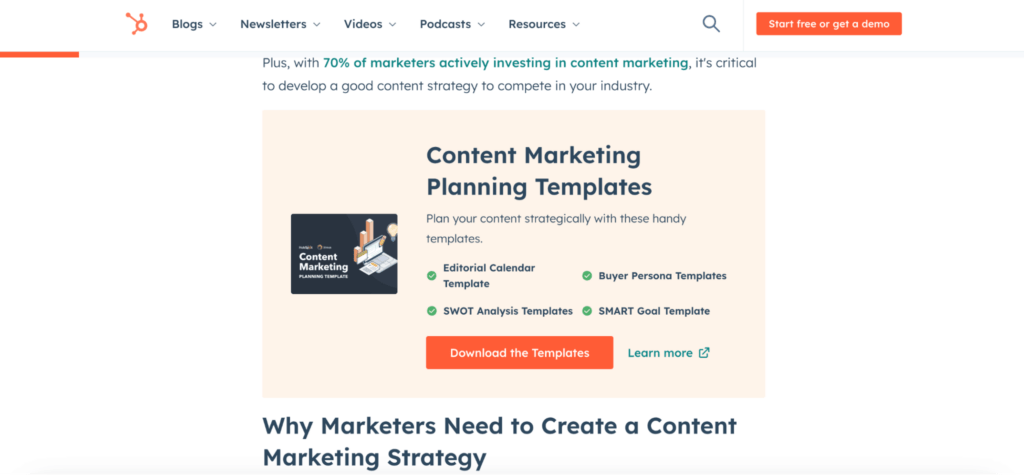
Repurpose and update
This SaaS brand is notorious for making the most of its resources. In one article, HubSpot recognized that 76% of monthly page views came from old blog posts rather than recently published pieces [2]. Consequently, updating old posts [3] is a crucial step in HubSpot’s efforts. Additionally, since each piece goes into depth on every topic, they aim to create evergreen articles that continue to rank today. Moreover, sticking with the theme of prolonging their resources, the team repurposed much of their work. For example, it’s not uncommon to see a staple high-energy video from their team that reflects an older blog post.
Lead generation
HubSpot used its content to generate super-targeted leads by offering helpful resources in exchange for contact information. This allowed them to build a database of potential users interested in their products and services. For example, many of their articles or videos offer a free download, such as a calendar or blog post guidelines. By providing a direct reward, more people are likely to sign up for their email list and become qualified leads.
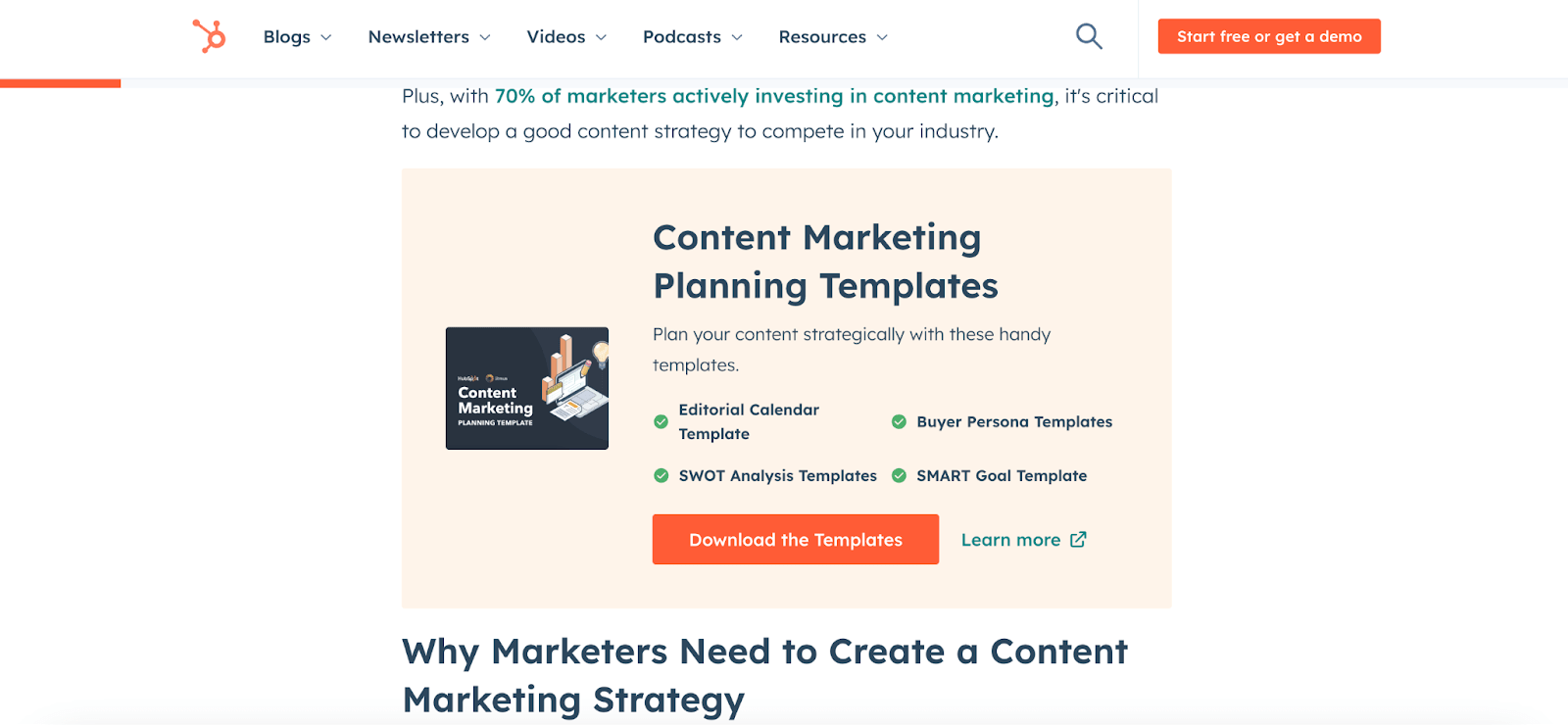
Alt-text: A HubSpot blog post showing an incentive in their B2B SaaS marketing campaign to drive new email sign-ups and successfully segment their audience.
Automation
They also leveraged automation tools to nurture leads and guide them through the sales funnel. By delivering personalized pieces and targeted messaging, they were able to convert leads into customers more effectively.
Main Lessons
- Create helpful pages that address the ideal buyer’s needs and position you as an expert.
- Value should be the driving force. For instance, offering free resources in exchange for their contact information is a great lead generation tool.
- Ensure that your audience has access to targeted resources tailored to their specific needs, as this facilitates easier segmentation.
- Leverage automation tools to stay in touch with potential clients and segment your audience appropriately so you can guide them through the sales funnel.
2. Salesforce’s Dreamforce Event
Salesforce’s Dreamforce event offers another example of highly successful advertising efforts. Dreamforce is the business’s annual user conference and a highly-anticipated industry affair. During this four-day set-up, Salesforce brings together industry leaders, customers, and partners to learn, network, and explore the latest innovations in cloud computing. While 2009 saw an average of 19,000 attendees, by 2017, there were 170,000 people registered to attend. So, how did they do it?
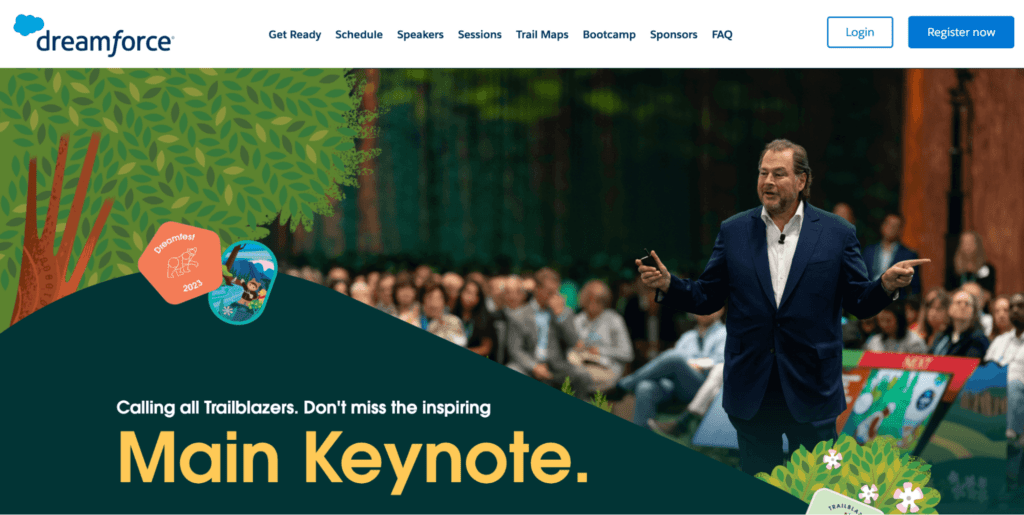
Key Elements
Brand building
The event showcases Salesforce’s products, thought leadership, and success stories. Every year, it brings a huge flurry of excitement as it takes on a festival-style event with stalls, speakers, interactive elements, and so much more. Over the years, Salesforce has made its conference a one-of-a-kind experience that industry professionals don’t want to miss out on.
Networking opportunities
Dreamforce provides attendees ample opportunities to network with industry peers and potential customers. This helps build relationships and generate new business prospects. Moreover, they use Dreamforce to share insights, trends, and best practices in the industry, positioning them as a thought leader and building trust and credibility among their target audience.
Responsive
Since the global pandemic stalled their annual festivities, Salesforce responded with a campaign called ‘Dreamforce to You.’ They turned the event into a virtual gathering and offered free registration to those who signed up. They managed to register over a million people and increased the sales pipeline by 50%. While they couldn’t host to the scale they usually would, Salesforce used their established presence and anticipation to skyrocket their lead generation efforts.
Main Lessons
- Create a recognizable brand by using cohesive messaging and imagery, including developing a brand experience that resonates with your audience and remains consistent.
- Utilize value-driven events for your audience, such as webinars, to present your products, thought leadership, and success stories.
- Consider creating a community forum through Slack or other channels to provide networking opportunities and generate new business options.
3. Slack’s Viral Marketing Campaign
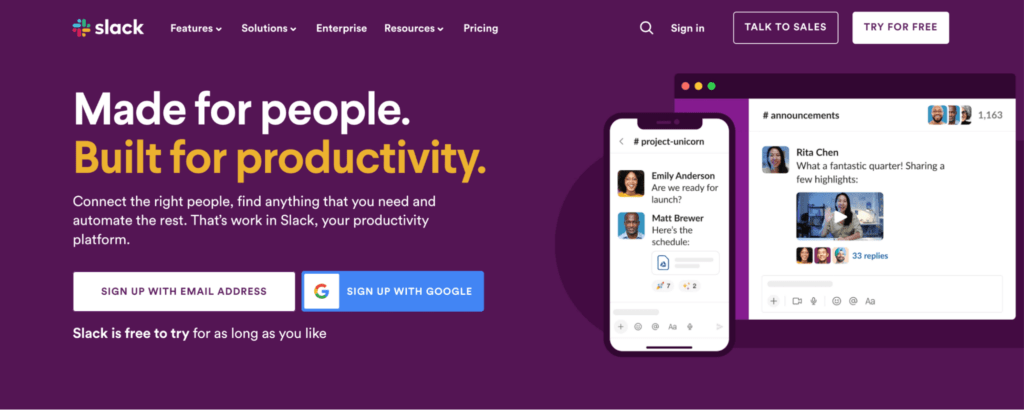
If you’re looking for a prime example of a viral campaign, check out Slack. The company leveraged word-of-mouth and social sharing to achieve rapid success by highlighting the key benefits of its platform. For example, it quickly became a favored team communication tool in part due to its innovative features and user-friendly interface.
Key Elements
Product-market fit
Slack identified a gap in the market for a better team collaboration tool and developed a product that addressed the pain points of its target audience. They positioned themselves as an alternative to email, which posed many problems for businesses’ internal communications. This strong product-market fit was crucial for the success of their viral B2B SaaS marketing campaign, and immediately started creating demand for their software.
Ease of use and integration
Slack’s intuitive interface and features made it easy for subscribers to adopt and share the product with their colleagues. Integrating with tools such as Asana and Google Tools was a critical step in making the software simple. Furthermore, by making the onboarding process smooth and adopting a freemium model, Slack made sure its platform quickly became a part of the user’s core infrastructure. So, when it came to upgrading to a paid plan for more contacts and space, it was a natural progression for the majority of their audience, who weaved the software into their daily operations without any friction. This led to organic growth and viral adoption within organizations.
Community building
They encouraged community building by creating forums and groups where customers would share their experiences and ask questions. Through these channels, Slack has created a sense of belonging and loyalty amongst its clientele.
Referral program
Slack implemented a referral program that rewarded users for inviting their friends, family, and colleagues to join the platform. This incentivized them to spread the word about Slack and contributed to its increase of eight million global users.
Main Lessons
- You can use demand generation tactics to identify a gap in the market and develop a product that addresses the pain points of your audience.
- Focus on creating a friendly interface and intuitive features that encourage easy software adoption and sharing.
- Implement a referral program to incentivize users to spread the word about your product.
4. Loom Masters Demand Generation
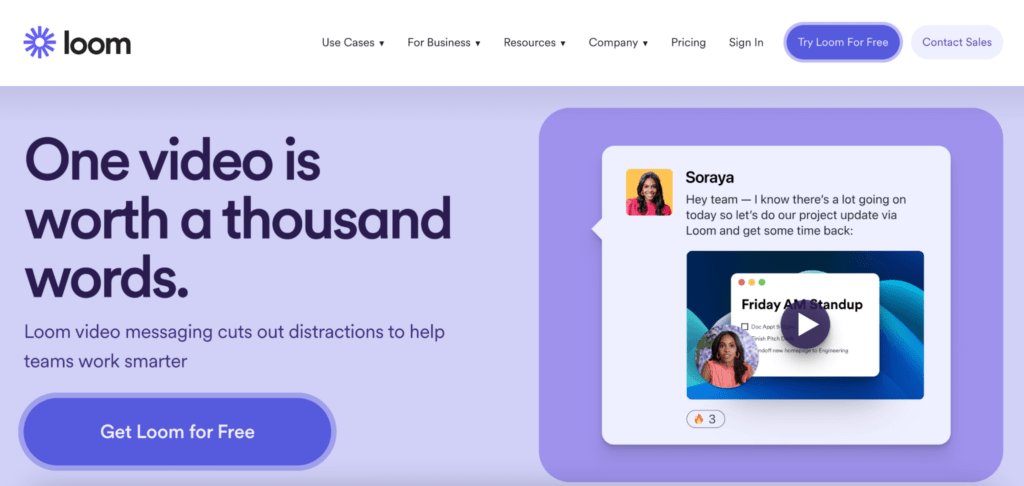
Next up, we have Loom’s demand generation method. So, what is Loom? It is a video messaging tool that allows users to record and share videos with their colleagues. Its route to success demonstrates how a software company can effectively build interest and leads for its product. Rather than relying on blog posts, Loom used a product-led GTM strategy. People got to see how their video recording and distribution tool solved a direct problem for the B2B sector.
Key Elements
Fast-instant time to value
Loom made the software free and easy to use when it initially went to market. People would record and share a video within a matter of clicks, letting them see the tool’s value almost immediately. This is one of the primary methods that led to their viral success.
User feedback
Instead of copying and adapting their competitors’ features, Loom became hyper-aware of their customer’s experience. They asked questions and responded to feedback to check their platform addressed the exact issues their audience was facing. For example, they created editing and storage capabilities and continuously updated their community about new features and updates. This helps make users feel appreciated and a part of something bigger.
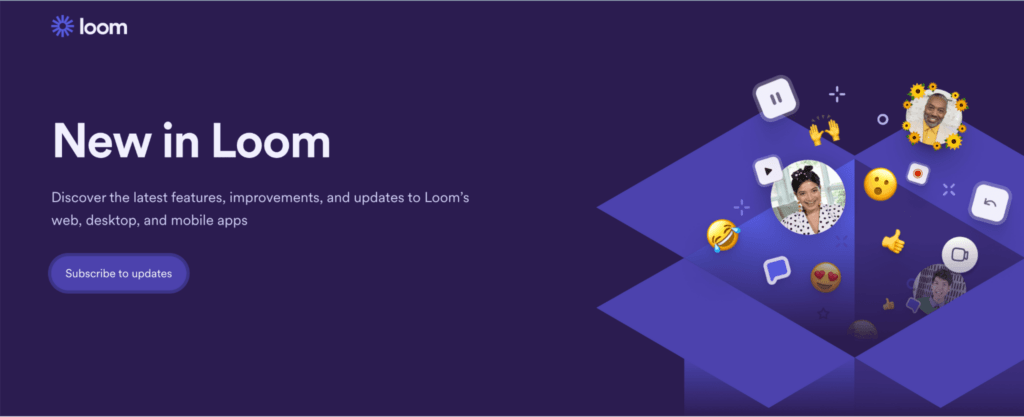
Targeted messaging
While the old slogan read, ‘free screen & video recording software,’ Loom pivoted to a more targeted phrase, ‘video messaging for work.’ They clearly defined their B2B audience and broke into the rapidly growing SaaS sector.
Use cases
As they adapted their campaign, they focused on specific industries and job titles most likely to benefit from their product. Loom created distinct use cases to show potential clients how to use the software, such as product demo walkthroughs, customer support, and user feedback. They even geared new features to this demographic, including a video library, more advanced sharing capabilities, call-to-actions, file attachments, and password activation.
Main Lessons
- Use targeted messaging (such as use cases) and advertising to reach your ideal buyer and demonstrate exactly how they might use the software.
- Minimize the time to value with a free trial or demo. This will remove the barriers to adoption and encourage users to try your product.
5. Dropbox’s Referral Program

From 2008 to 2017, the cloud storage and file-sharing platform Dropbox increased registered users from 100,000 to an impressive 33.9 million. Alongside feedback and product development, referrals made all the difference. Thus, Dropbox is a classic example of how a B2B SaaS company can leverage the power of referrals to acquire new buyers.
Key Elements
Incentives were two-fold
Not only did Dropbox provide incentives to the referrer but also to the referred person. When a user recommended someone to Dropbox and signed up, both the referrer and the referred received additional storage space for free. This dramatically encouraged people to get their friends and colleagues on the platform to gain more free space. Thus creating a viral loop as the friend could now invite more people.
Integrated into onboarding
It’s no secret that a straightforward onboarding process is the key to converting many customers. However, Dropbox took this a step further by implementing this recommendation step into the last stage of the onboarding procedure, making it organic and necessary to get free storage space.
Ease of sharing
Dropbox made it easy to share recommendation links through email, social media, and other channels. This streamlined the process and encouraged more people to participate in the program.
Referral tracking
A standout element of this B2B SaaS marketing campaign is the ability to track referral status. Users can see who they’ve recommended and if that has led to a reward. This way, Dropbox shows that it cares about every referral and getting people the rewards they deserve.
Main Lessons
- Offer genuine incentives that benefit all parties.
- Make it easy to share their referral links through various channels.
- Incorporate a viral component into your referral program to create a sense of competition and urgency.
6. Zendesk’s Content Creation
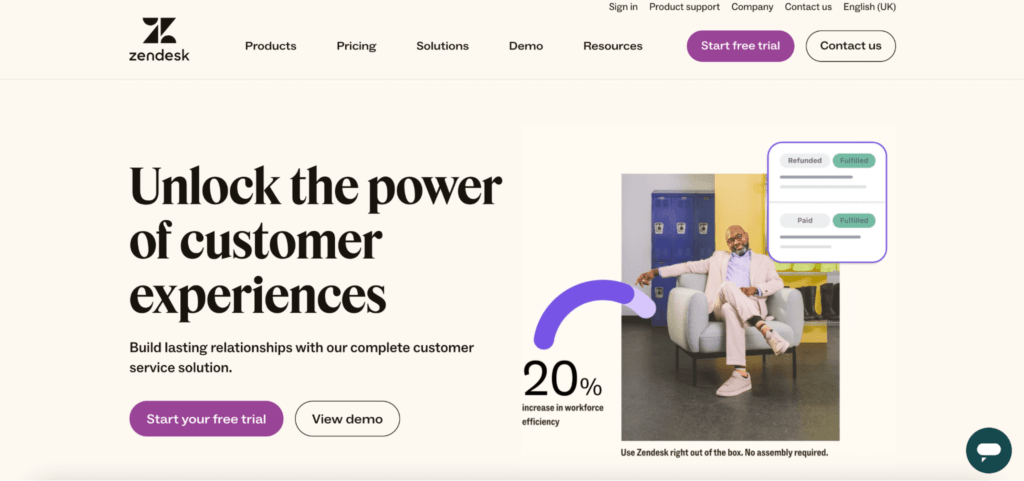
In the B2B SaaS division, using content to position yourself as an expert is crucial to building credibility and trust. Zendesk, a customer service software platform, is a prime example of this approach to attract, engage, and convert potential leads. In fact, the data shows that approximately 70% of their generated leads come from organic sources, with content at its heart.
Let’s dive into the core components of their success:
Key Elements
Customer-centric
Zendesk focused on creating pages that addressed their target audience’s challenges. They provided valuable resources, such as blog posts, ebooks, and webinars, that helped businesses improve their customer service operations.
Topic clustering
Zendesk positioned itself as a thought leader in the service industry by sharing insights, trends, and best practices. They did this by using a topic clustering technique that means for every overarching topic, they have several other related blog posts that offer more depth. It’s the perfect remedy for internal and external linking, building trust and credibility among their target audience and search engines. Additionally, Zendesk is known to prioritize quality over sheer volume. So, while they might not match their competitors in quantity, they aim to outshine them with quality.
Main Lessons
- Create solution-focused content that aligns with your audience’s challenges.
- Check you have covered the entirety of the topic by using a clustering method.
7. Intercom’s Mastery in SEO for B2B SaaS Marketing
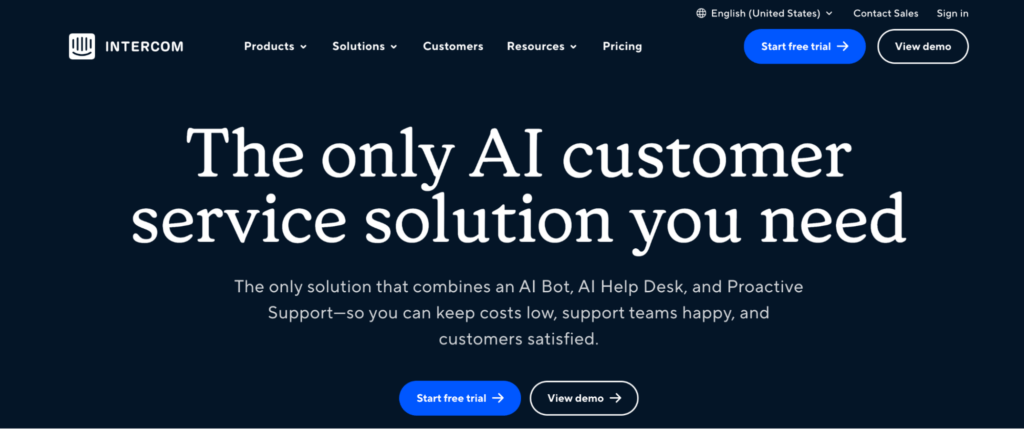
Intercom, a dynamic player in the software sector, has achieved a staggering jump from $0 to a whopping $50M in annual revenue in just a span of four years. Out of this, an impressive $49M was accrued in merely the last three years. What’s even more commendable? They’re on the fast track, potentially becoming the second-quickest SaaS business, after Slack, to hit the $100MM benchmark. Their secret weapon? A brilliant integration of content with SEO, driving both brand visibility and a flood of traffic into their sales funnel.
Key Elements
Evergreen content
At the heart of Intercom’s approach lies the concept of evergreen content. This aims to continually draw potential buyers at the top of the SaaS marketing funnel. By zeroing in on persona-specific keywords, such as ‘user engagement’ or ‘pricing models,’ Intercom ensures that their articles become the maiden touchpoint for would-be buyers. This strategy doesn’t just guarantee consistent inbound traffic, but it also aligns with visitors who are potential buyers, perhaps not immediately but eventually.
Relevant CTAs
Creating top-tier pages is one thing, but guiding the audience towards actionable steps is another. Intercom masterfully incorporates ‘Next Steps’ cues, attractive content upgrades, and newsletter sign-ups. Their aim? Convert a chunk of their traffic into tangible prospects within their funnel, expanding their reach and fostering a relationship via targeted emails and content offerings.
Supplement with retargeting
Ever browsed a website only to find its adverts following you elsewhere online? That’s the power of retargeting. Intercom doesn’t just use this tactic; they master it. If a user reads an article on Intercom’s site and later transitions to Facebook, they’re likely greeted with an ad offering a free trial of Intercom’s services. But their genius lies in the granularity. Depending on the articles read, they’re segmented accordingly so the retargeted ads resonate with their specific interests.
Link building through thought leadership
Earning backlinks isn’t just about quantity but quality and relevance. Intercom nails this by focusing on thought leadership. They tap into intriguing trends within their industry, delivering their unique perspectives on topics like customer support or startup promotion. As these ideas gain traction, their articles organically amass backlinks from other writers exploring similar themes.
Main Lessons
- Be specific in your SEO efforts. For example, targeting persona-specific keywords ensures the pages speak directly to potential buyers.
- Keeping visitors engaged through retargeting can optimize conversions.
- Intercom’s link-building strategy underscores the importance of producing high-quality, thought-provoking content over mere volume.
8. Adobe’s Innovative Branding Efforts: A Deep Dive
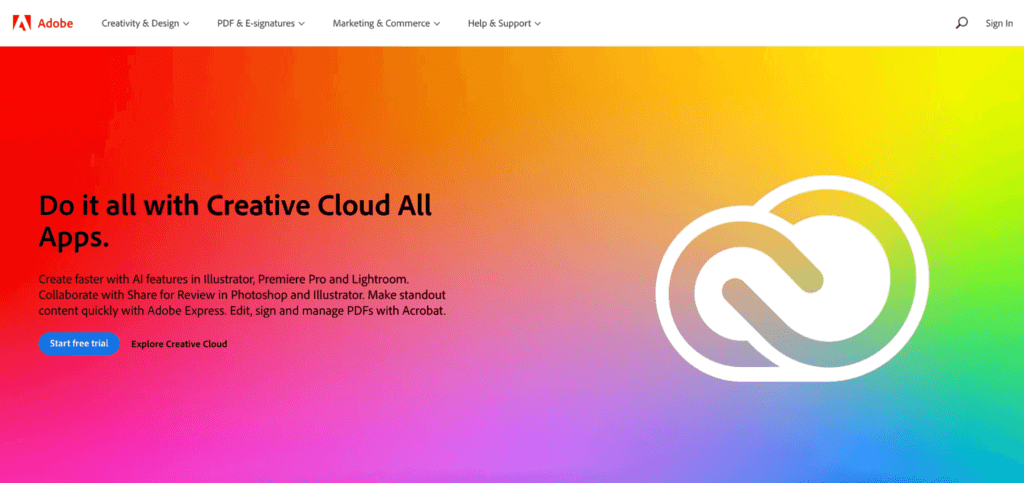
Adobe, a household name in design and creativity software, has successfully pivoted its business model and strategies to maintain its leading position in the industry. Since its transition to a SaaS model in 2013, which gained four million new subscribers in just 2.5 years, its achievements have been underpinned by aesthetic designs, seamless user experiences, content strategies, and more. Let’s dissect Adobe’s promotion to glean lessons for aspiring businesses.
Key Elements
Stellar design and UX
Adobe’s visuals mirror the essence of their flagship products – impeccable design. The minimalist, cohesive aesthetic across their assets speaks volumes about their commitment to visual excellence from social media to email. Furthermore, the focus on an intuitive user experience ensures that visitors can quickly discern the value of the Creative Cloud and are prompted to engage further, be it through a free trial or by exploring in-depth product details.
Strategic SEO approach
Despite being an industry giant, Adobe maintains a steady focus on optimization. While their organic traffic and keyword rankings show marginal changes over time, this stability in a complex digital environment is a testament to their market position. Further, their brand-related keyword dominance underscores the importance of recognition in SEO success.
Content excellence
The content aligns with creative professionals and business leaders. For example, user-generated content (UGC) fosters a vibrant community of Adobe tool enthusiasts. Plus, their informative blog entries not only educate about intricate design features but also offer a space for creative professionals to collaborate and share.
Events and conferences
Beyond digital, they leverage physical events like conferences to connect creatives and digital marketing mavens. These events serve as knowledge exchanges and further cement Adobe’s position as an industry thought leader.
Focused ad spend
Adobe’s advertising reveals meticulous planning. They allocate their resources towards video, direct advertising, and programmatic advertising, showcasing their commitment to diverse channels. Their adaptability in reallocating funds based on ad performance underscores their agile plan.
Main Lessons
- Prioritize brand values and functionality by balancing design and user experience. This can significantly enhance brand perception and engagement.
- Creating platforms or pages that allow people to engage, collaborate, and share can amplify brand loyalty.
Even for industry giants, there’s always room for optimization. Whether refining content or reallocating ad spend, staying attuned to performance metrics and making iterative improvements is crucial.
9. Mailchimp’s Evolution in B2B SaaS
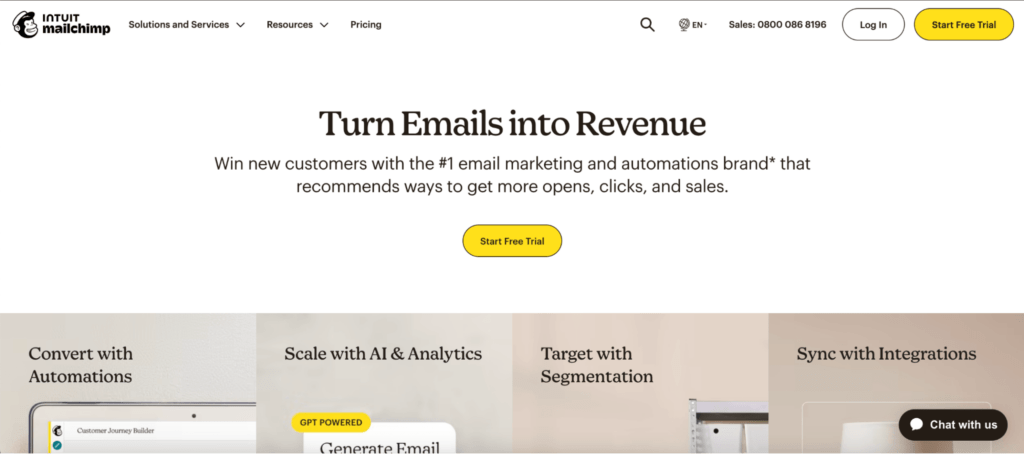
If you’re hunting for a masterclass on how to nail B2B SaaS marketing campaigns, look no further than Mailchimp. Initially recognized as an email tool, Mailchimp has matured spectacularly over the years, morphing into a holistic marketing platform. Its impressive array of features has captured the attention of over 12 million active users as of 2019.
Key Elements
Leverage social media for remarkable brand awareness
Mailchimp cleverly taps into Facebook Custom Audiences to make the most of their substantial email list. They’ve mastered the art of advancing their audiences through the funnel with targeted ads. Their audacious ‘Did You Mean MailChimp?’ campaign – inspired by the unintentional mispronunciation ‘MailKimp’ – showed their ingenuity. This captivating campaign was unique and generated extensive online discussions, amplifying their brand recognition.
Prioritizing key audience segments
Mailchimp has honed in on its highest revenue generators: agencies. Their one-of-a-kind offerings, like the Agency Account, Agency Newsletter, and Agency Content Series, specifically cater to these stakeholders, ensuring they receive exclusive benefits that make their operations smoother and more efficient.
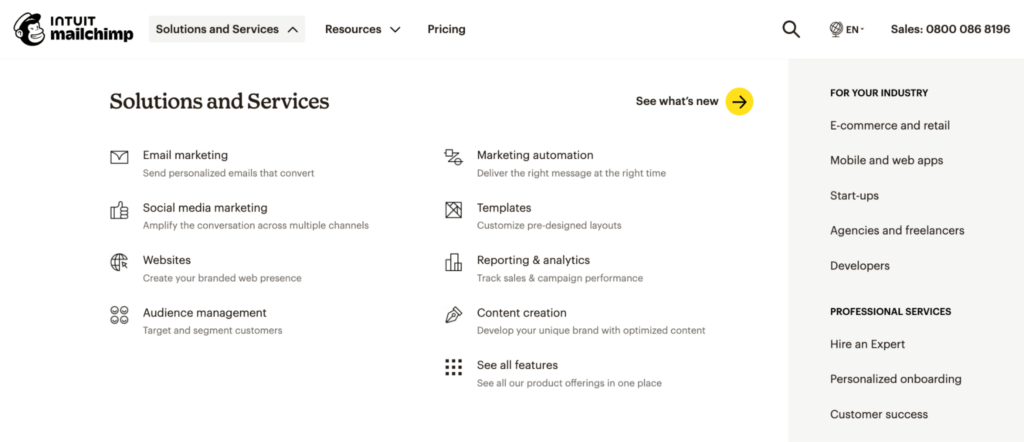
Pivoting strategies based on outcomes
Mailchimp isn’t afraid to adapt. They initially hopped on the trend of using Medium for their blog but later transitioned back to their main website. The reason? They wanted a dedicated resource hub tailored to their different buyer personas.
Harnessing affiliate marketing
Lastly, Mailchimp’s ‘MonkeyRewards’ badge is a stroke of genius in the world of SaaS affiliate marketing. This badge, embedded in every email footer sent by free account holders, serves as a hyperlinked logo, redirecting to Mailchimp’s homepage. A brilliant plan, this incentivizes brand promotion, offering mutual benefits for both the company and its users.
Main Lessons
- Understand and prioritize your customers’ needs.
- Embrace multichannel strategies to reach a broader audience.
- Continuously review and refine your strategies based on feedback.
- Target specific segments that can amplify your brand.
- Explore affiliate marketing with mutual benefits for both parties.
10. Zapier: An Analysis Into Their B2B SaaS Efforts
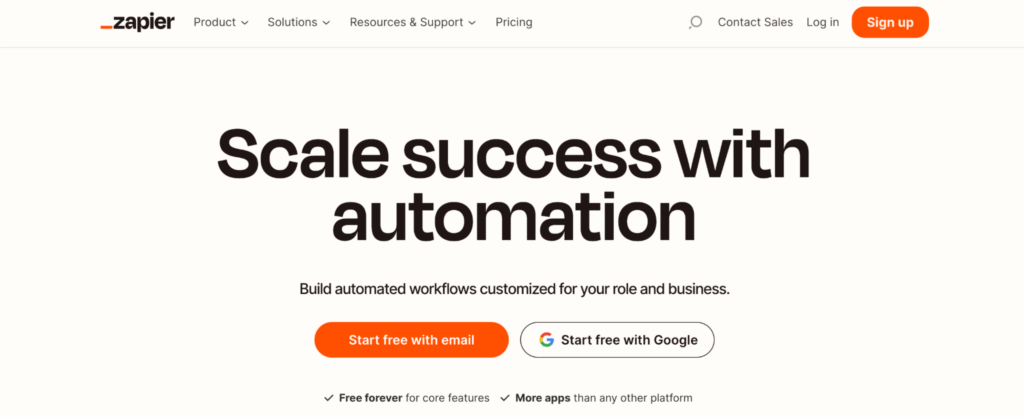
Zapier is a renowned automation tool that connects various apps to easily navigate repetitive tasks. While the term ‘automation platform’ might not have a high search demand, Zapier’s marketing, especially in the realm of SEO, has been nothing short of impressive. Their strategy has been so effective that their blog alone attracts 1.6 million organic visits every month, accounting for a significant portion of their overall organic traffic.
Key Elements
Pitching the product through the back door
Instead of directly promoting their product, Zapier introduces it through related high-volume keywords. For instance, an article about ‘to-do list’ apps might not directly discuss their solution, but it introduces the platform through various ‘back doors,’ leading to product articles. This channels a significant amount of traffic to its main pages.
Ranking for other people’s keywords
Zapier leverages the demand for other apps by listing integrations between these apps. For example, if someone is looking for an integration between Dropbox and Google Drive, Zapier showcases how it can facilitate this connection, driving organic traffic to their site.
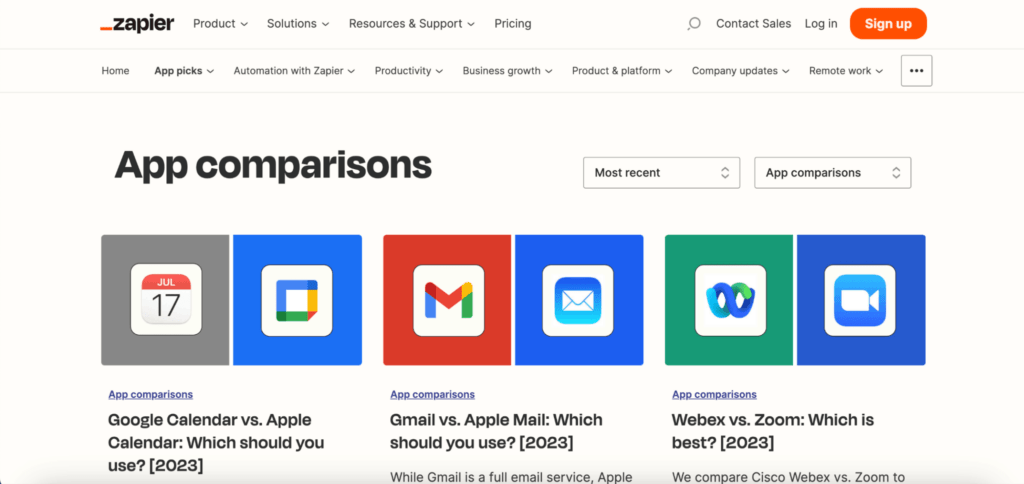
Self-building resource hubs
Zapier organizes its existing content into hub structures, linking new related pages as it’s created. This allows them to expand their scope without taking significant risks.
Link baiting
Original research, even if concise, can act as a powerful link that other businesses want to reference. By answering pertinent questions and concisely presenting the findings, Zapier attracts high-quality backlinks.
Interlinking
Zapier’s SEO is characterized by dense interlinking. From blog posts to hubs to original reports, everything is interconnected, helping with page rankings and user navigation.
Diverse content creation
Not all of Zapier’s pages are created for SEO. They also produce articles on topics like productivity and well-being, which might not necessarily drive organic traffic but resonate with their audience.
Main Lessons
- Even if your product doesn’t directly align with high-volume search terms, you can still drive traffic by targeting high-demand topics and weaving your product into the narrative.
- By showcasing how your product integrates or complements other popular products, you can tap into their search demand.
- When it comes to original research, it’s not always about the length. Concise, relevant research can attract a significant number of high-quality backlinks.
- Dense interlinking not only helps with SEO but also enhances user experience, guiding visitors through a journey on your site.
- Produce content that rings true with your audience, even if it doesn’t drive significant organic traffic. This helps in building a genuine connection with your readers.
11. Monday.com: A Data-Driven Powerhouse
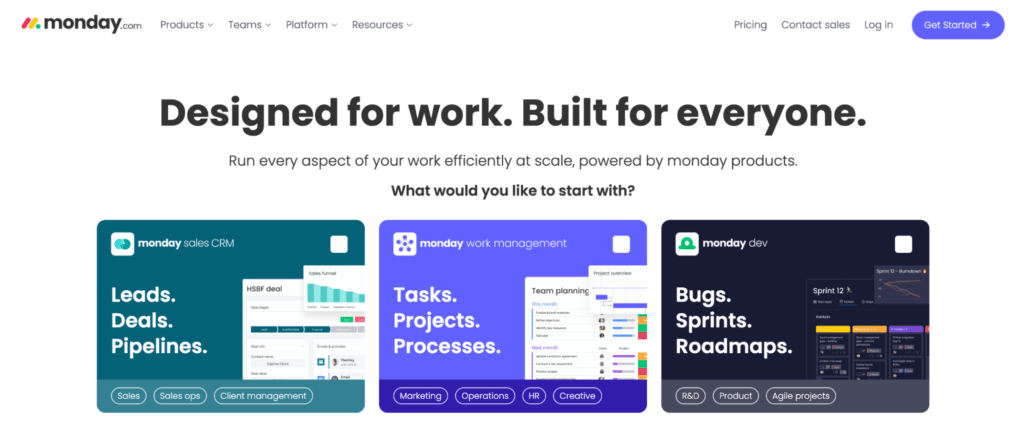
Monday.com has swiftly become a forerunner in project management software since its inception in 2014. A glance at the data reveals an impressive upsurge in revenue, soaring by approximately 75% within a mere quarter to tip over the $120 million mark. But what’s behind this success? Surely, it isn’t just the product’s prowess. Dive deeper, and you’ll uncover a meticulously crafted, data-backed marketing plan.
Key Elements
Content mastery
With over 1,300 tailored blog articles, Monday.com champions long-form pieces, perfectly mixing education with product showcases and ranking high in SEO. Plus, by intertwining educational pages with product demonstrations, they subtly showcase their product’s capabilities.
Audience segmentation
They meticulously segment their blog to cater to various industries and use cases, ensuring targeted and relevant delivery. This is also an excellent way to direct qualified leads down the sales funnel.
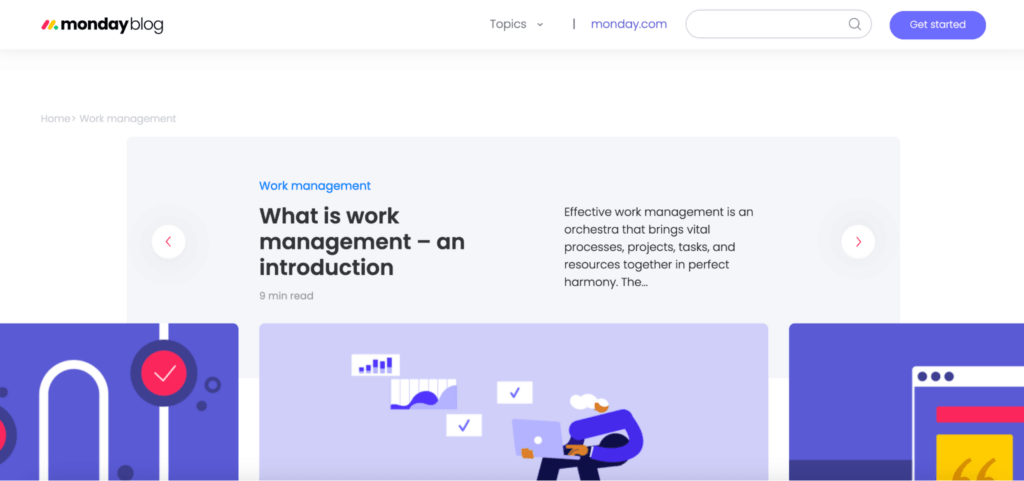
Data-driven
Utilizing tools like BigBrain, Looker, and HubSpot, every decision is rooted in robust data analysis, from content strategies to site design decisions.
Varied social media and online presence
Their unique content structure spans diverse platforms, from LinkedIn professionalism to Instagram playfulness, coupled with a resourceful YouTube channel for product guidance. For example, their channel has tutorials, tips, and guides, educating their audience about the platform’s capabilities. By leveraging a personal brand on LinkedIn, they can further enhance their professional reach and credibility.
Internal and external linking boosts SEO
A robust linking strategy can enhance a website’s domain authority, driving organic traffic and improving search rankings.
Beyond digital outreach
Monday.com’s reach extends to the real world, with global events and notable ads in places like the New York subway.
Main Lessons
- Blend quantitative and qualitative data to add depth to the understanding and ensure a balanced SaaS marketing plan.
- Producing relevant resources about the audience’s needs and preferences can drive significant scaling. Moreover, segmenting and categorizing this information can further enhance its impact.
What Makes a B2B SaaS Marketing Campaign Successful?
While each of the above strategies had its standout elements, some common factors contribute to the success of B2B SaaS marketing campaigns:
Understanding the Target Audience
You should always start with a deep familiarity of the target audience’s needs, pain points, and preferences. This allows you to create messaging and content that aligns with your potential clients. If you only do one thing to improve your promotional efforts, focus on specific pages relevant to your ideal customer. Plus, if you can personalize your campaigns, even better! This has been shown to drive engagement.
Providing Value
The best offer value to viewers through educational content, thought leadership, or useful tools. Focusing on soft-selling in the form of learning materials can build credibility, positioning your company as a trusted advisor.
Leveraging the Right Channels
As you saw in the above examples, the brands were intentional about where they market. Knowing which platforms to use is a direct link to your target audience. This could include social media, email marketing, content creation, events, or influencer partnerships. For some, this might extend into outdoor advertising, such as billboards.
Measurement and Optimization
The real trick to continued success is analyzing the performance of your efforts to identify areas for improvement. This allows your marketers to optimize strategies and tactics for better results.
o learn more about effective sales strategies and communication tools, listen to the Nuoptima SaaS Podcast featuring Chris Baden from FlowChat.
Ask the Experts: We Have a Knack for B2B SaaS Marketing Campaigns
At NUOPTIMA, we understand the intricacies of B2B SaaS and the unique challenges it presents. With the digital landscape constantly evolving, it’s essential to have a partner who stays ahead of the curve, and that’s where we come in.
1. Comprehensive SEO Expertise
As a dedicated SEO agency, we specialize in organic ranking improvement and SEO strategy on Google. Our track record speaks volumes, with case studies showcasing significant improvements in organic positions, traffic development, and ROI. Whether you’re a B2C or B2B enterprise, our strategies are tailored to guarantee you’re visible to your ideal buyers.
2. Engaging Email Marketing
Email remains a powerful tool in the B2B space. Our team crafts conversion-optimized email campaigns that not only engage your audience but also retain customers and drive sales. From understanding your leads to executing list expansion strategies, we make your email communications resonate and convert.
3. Profitable Ads
Do you want to acquire ready-to-buy customers? We design our ad strategies to target high-buying intent keywords, ensuring you get the most out of every penny spent. We manually manage bids, set up full-funnel tracking, and optimize for best results. So, when someone actively searches for your solution, we’ll get your site in front of them.
4. Award-Winning Services
Our success hasn’t gone unnoticed. We’ve been recognized for our outstanding work, including winning the Best 2022 B2B SEO services Campaign in the UK Search Awards.
5. Partner in Growth
Beyond our services, what truly sets NUOPTIMA apart is our approach. We’re not just an agency; we’re business builders. We’ve been in your shoes, understanding the challenges and opportunities firsthand. Our commitment is to ensure you skip the wasted time and money so you grow profitably.
In a world where every click, impression, and conversion counts, let NUOPTIMA be your beacon. Together, we’ll navigate the complexities of B2B SaaS promotion, making your brand shine and achieve sustainable growth.
Final Thoughts
Navigating through the innovative waters of B2B SaaS marketing campaigns, from the compelling strategies of Slack to the engaging approaches of Loom and the adaptability showcased by Zapier, it’s evident that success hinges on more than just a brilliant product. It’s about truly understanding your audience, crafting a message that resonates, and delivering it through the right channels.
The hallmarks of an outstanding marketing campaign are intricately tied to a brand’s ability to connect, communicate, and create lasting relationships. If these examples have inspired you, and you’re keen to sculpt a similarly impactful strategy for your enterprise, don’t hesitate. Book a call with our experts at NUOPTIMA, and let’s turn those aspirations into tangible success.
